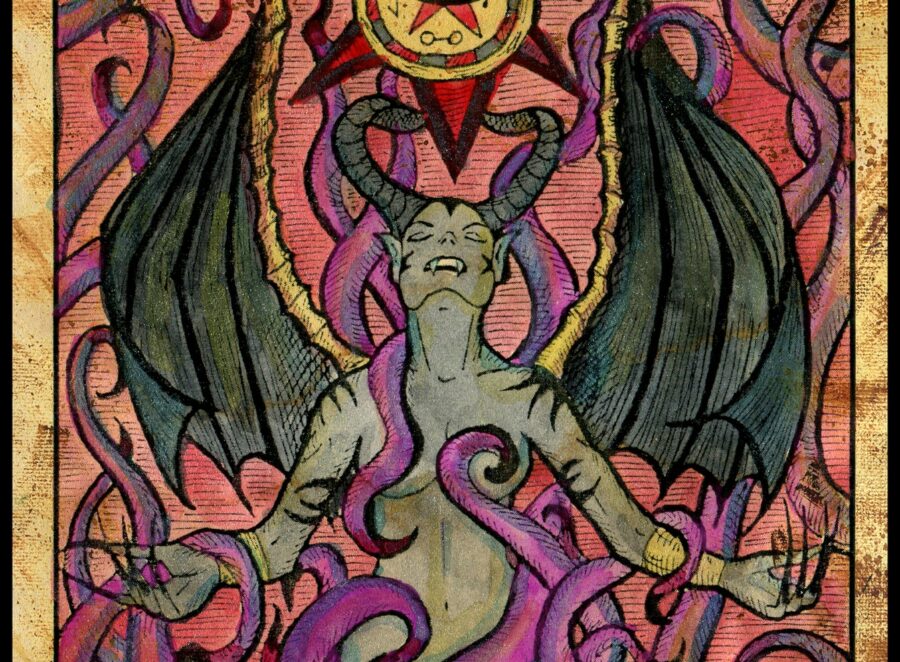There’s Nothing New About Worshiping Abortion, or Linking Feminism to Satan

A new “church” in California just opened: The Church of Potential Life. It was established in response to the Supreme Court Dobb’s decision, MSN Insider reports. It isn’t a church to pray for the unborn, as the title could suggest, but to worship abortion and female autonomy.
The founder, Jackie DesForges, said her “anger and sense of grief over the loss of abortion rights” led her to “create the provocative symbol of hope.”
DesForges, an apostate Catholic, drew from her upbringing by calling the worship “a mass.” Her church uses an altar and iconography, including an appropriated image of the Virgin Mary. “The project,” she explains, “was also an act of reclaiming a sacred space after she left the church and recognized different religious perspectives on abortion.”
The surprising thing shouldn’t be that this “church” exists, but that it hasn’t happened before.
A New, Demonic Model for Women
In my forthcoming book, The End of Woman: How Smashing the Patriarchy Has Destroyed Us, I look at the earliest roots of feminism. Many contemporary feminists speak about how the movement was hijacked by Marxist ideologies in the 1960s and 70s. I decided to look at the philosophical ideas behind feminism’s first wave. What I discovered was shocking. The “pure” movement I’d hope to find has never existed.
Percy Bysshe Shelley (1792-1822) isn’t who people usually think of when it comes to women’s issues. This Romantic poet, known for breaking taboos and seducing women, cemented the three pillars which would animate the feminist movement: 1) to restructure society (which evolved into smashing the patriarchy), 2) free love or the end of monogamy, and 3) the occult.
As the son-in-law of feminist founder, Mary Wollstonecraft (1759 -1797), Shelley wanted to free women from what he, like his mother-in-law, considered slavery. In his fervor, Shelley created the character Cythna, a new kind of woman, who lived without the ties of husband or children. Her one bond was to Satan. She was to become the voice of the feminist revolution.
The Victorian feminist Mathilde Blind (1841–1896) described “Cythna as ‘a new female type’ with no previous parallels in literature. All other women, Blind explained, “had depicted her invariably in her relation as either wife or mistress, mother or daughter.” This new woman was no supplement to man’s nature. Shelley sparked something new in women’s imagination, the ideal of complete female autonomy.
Eve Was a Trailblazer, and Satan Her Ally in Empowerment
In addition to Cythna, Shelley reinterpreted Genesis 3 and the fall of man with women in mind. Eve, rather than the source of man’s banishment from Eden, becomes the heroine. The snake who tempts Eve, offers her gateway for truth and wisdom. Eve’s temptation, in Shelley’s reading, is an opportunity, not a closed door.

Shelley’s radical ideas took root and eventually influenced first Helena Petrovna Blavatsky (1831-1892), who founded Theosophy. A Russian noblewoman, Blavatsky traveled the world, supporting herself as a medium. A mishmash of voodoo, native American spirituality, and Buddhism, Theosophy embraced a pro-Satanic counter-myth to the Bible, much like Shelley’s.
Grandmother of feminism, Elizabeth Cady Stanton (1815-1902), became a theosophy enthusiast and applied many of its concepts to her writing. Cady Stanton, who rejected the Christianity of her youth, wrote The Woman’s Bible, offering a feminist critique of scripture, with many of the contributors also theosophy adherents. The Woman’s Bible caused such a stir that she was disowned by the National American Woman Suffrage Association, of which she was the honorary president.
Marxism, Witchcraft, and Abortion
Theosophy never quite went away and enjoyed a resurgence in the 1960s. Gloria Steinem’s mother was an adherent prior to her own mental breakdown.
The three elements, the occult, free love, and smashing the patriarchy, that underpinned first wave feminism were certainly not embraced by all suffragettes. They were, however, the concepts that kept the feminist movement afloat until the 1960s, when a more radical version took over. Feminism was influenced by the Bolsheviks (whose regime was the first to legalize abortion), then by the cultural Marxists of the Frankfurt School, which took it into the second wave.
Please Support The Stream: Equipping Christians to Think Clearly About the Political, Economic, and Moral Issues of Our Day.
Second wave feminism continued Shelley’s legacy. One of its most popular books was Robin Morgan’s anthology Sisterhood Is Powerful. It was a kind of handbook for feminists working to raise their consciousness and throw off the patriarchy’s shackles. Among its entries is the suggestion that the lesbian lifestyle is preferable because it naturally frees a woman from men and children. The book also includes a section featuring WITCH, the Women’s International Terrorist Conspiracy from Hell, which suggests practicing witchcraft for female emancipation. The appendix includes spells for everyday use.
The question the first wave feminist asked was how do we help women. A noble effort. The problem is that they saw the life of men as the solution. Rather than helping women as women, they wanted to help women become men. No more fuss and mess of families, husbands, birth, and child-raising.
The goal was for women to become like men, or better like gods, without the confines of bodies and human nature. For this to happen, women had to prevent or eliminate their children and live only with potential for human life, not actual human life. California’s new church, the Church of Potential Life, fetishizes what Shelley and other first wave feminists dreamed of, now all too real for us.
Carrie Gress is a Fellow at the Ethics and Public Policy Center, a scholar at the Institute for Human Ecology at Catholic University of America, and the founder and co-editor of the online women’s magazine Theology of Home. She is the author of ten books, including The End of Woman: How Smashing the Patriarchy Has Destroyed Us. A married mother of five, she lives in Virginia.







